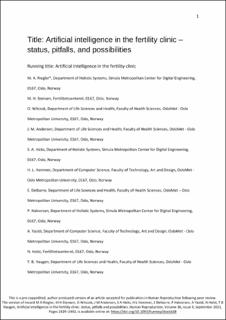| dc.contributor.author | Riegler, Michael Alexander | |
| dc.contributor.author | Stensen, Mette Haug | |
| dc.contributor.author | Witczak, Oliwia | |
| dc.contributor.author | Andersen, Jorunn Marie | |
| dc.contributor.author | Hicks, Steven | |
| dc.contributor.author | Hammer, Hugo Lewi | |
| dc.contributor.author | Delbarre, Erwan | |
| dc.contributor.author | Halvorsen, Pål | |
| dc.contributor.author | Yazidi, Anis | |
| dc.contributor.author | Holst, Nicolai | |
| dc.contributor.author | Haugen, Trine B. | |
| dc.date.accessioned | 2022-03-24T15:39:10Z | |
| dc.date.available | 2022-03-24T15:39:10Z | |
| dc.date.created | 2021-11-08T09:47:44Z | |
| dc.date.issued | 2021-07-29 | |
| dc.identifier.issn | 0268-1161 | |
| dc.identifier.issn | 1460-2350 | |
| dc.identifier.uri | https://hdl.handle.net/11250/2987476 | |
| dc.description.abstract | In recent years, the amount of data produced in the field of assisted reproduction technology [ART] has increased exponentially. The diversity of data is large, ranging from videos to tabular data. At the same time, artificial intelligence [AI] is progressively taking place in medical practice and may become a promising tool to improve the success rate with ART. AI models may compensate for the lack of objectivity in several critical procedures in fertility clinics, especially embryo and sperm assessments. Various models have been developed, and even though several of them show promising performance, there are still many challenges to overcome. In this review, we present recent research on AI in the context of ART. We discuss the strengths and weaknesses of the presented methods, especially regarding clinical relevance. We also address the pitfalls hampering successful use of AI in the clinic and discuss future possibilities and important aspects to make AI truly useful for ART. | en_US |
| dc.description.sponsorship | The work on this article was partially funded by the Frimedbio project ReproAI granted by the Norwegian Research Council with project number 288727 | en_US |
| dc.language.iso | eng | en_US |
| dc.publisher | Oxford University Press | en_US |
| dc.relation.ispartofseries | Human Reproduction;Volume 36, Issue 9 | |
| dc.subject | Artificial intelligence | en_US |
| dc.subject | Machine learning | en_US |
| dc.subject | Assisted reproductive technology | en_US |
| dc.subject | Embryology | en_US |
| dc.subject | Semen analyses | en_US |
| dc.subject | Fertility | en_US |
| dc.title | Artificial intelligence in the fertility clinic: status, pitfalls and possibilities | en_US |
| dc.type | Peer reviewed | en_US |
| dc.type | Journal article | en_US |
| dc.description.version | acceptedVersion | en_US |
| cristin.ispublished | true | |
| cristin.fulltext | original | |
| cristin.fulltext | postprint | |
| cristin.qualitycode | 2 | |
| dc.identifier.doi | https://doi.org/10.1093/humrep/deab168 | |
| dc.identifier.cristin | 1952194 | |
| dc.source.journal | Human Reproduction | en_US |
| dc.source.volume | 36 | en_US |
| dc.source.issue | 9 | en_US |
| dc.source.pagenumber | 24 | en_US |
| dc.relation.project | Norges forskningsråd: 288727 | en_US |
